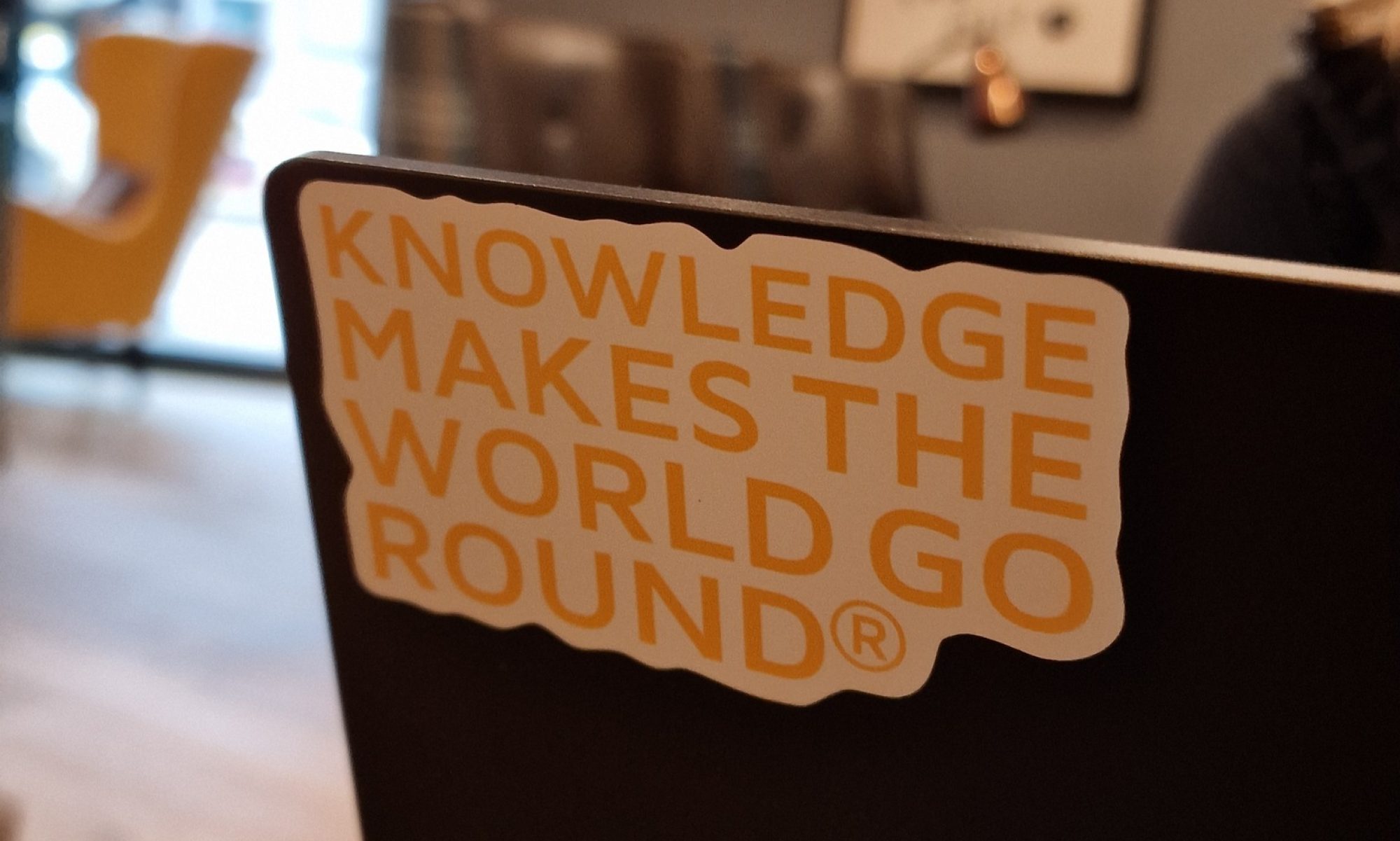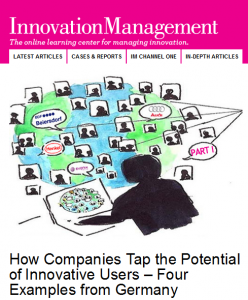 Die Überschrift des Blogbeitrags ist die (mehr oder weniger gelungene) Übersetzung des englischsprachigen Artikels How Companies Tap the Potential of Innovative Users – Four Expamples from Germany (InnovationsManagement, 03.12.2012), der aufzeigt, wie deutsche Unternehmen Open Innovation in ihren Innovationsprozessen nutzen. Weiterhin wird in dem Beitrag auch ein Rahmenmodell thematisiert, mit dem Unternehmen ihre Aktivitäten gezielter einsetzen können. Neben den wichtigen theoretischen Grundlagen enthält der Artikle somit auch direkt nutzbare Informationen. Sollte ihr Unternehmen an Open Innovation interessiert sein, so sprechen Sie mich bitte an.
Die Überschrift des Blogbeitrags ist die (mehr oder weniger gelungene) Übersetzung des englischsprachigen Artikels How Companies Tap the Potential of Innovative Users – Four Expamples from Germany (InnovationsManagement, 03.12.2012), der aufzeigt, wie deutsche Unternehmen Open Innovation in ihren Innovationsprozessen nutzen. Weiterhin wird in dem Beitrag auch ein Rahmenmodell thematisiert, mit dem Unternehmen ihre Aktivitäten gezielter einsetzen können. Neben den wichtigen theoretischen Grundlagen enthält der Artikle somit auch direkt nutzbare Informationen. Sollte ihr Unternehmen an Open Innovation interessiert sein, so sprechen Sie mich bitte an.
Freund, R. (2012): Co-Creation and Bottom-Up Economy
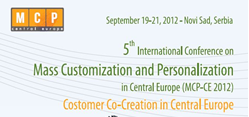 In der letzten Zeit wurde ich immer wieder auf meinen Vortrag Freund, R. (2012): Co-Creation and Bottom-Up Economy (PDF) angesprochen, den ich auf der MCP-CE 2012 gehalten habe. Es ging mir darum aufzuzeigen, dass Co-Creation nicht nur von Unternehmen genutzt werden kann, sondern jeden Anwender befähigt, Werte zu schaffen. Diese Entwicklung „von unten“ wird noch zu wenig beachtet. Sollten Sie zu meiner Präsentation Fragen haben, so können Sie mich gerne ansprechen. Siehe dazu auch Ein Europa von unten als Gegenmodell zum vorherrschenden Europa von oben, Reflexive Open Innovation.
In der letzten Zeit wurde ich immer wieder auf meinen Vortrag Freund, R. (2012): Co-Creation and Bottom-Up Economy (PDF) angesprochen, den ich auf der MCP-CE 2012 gehalten habe. Es ging mir darum aufzuzeigen, dass Co-Creation nicht nur von Unternehmen genutzt werden kann, sondern jeden Anwender befähigt, Werte zu schaffen. Diese Entwicklung „von unten“ wird noch zu wenig beachtet. Sollten Sie zu meiner Präsentation Fragen haben, so können Sie mich gerne ansprechen. Siehe dazu auch Ein Europa von unten als Gegenmodell zum vorherrschenden Europa von oben, Reflexive Open Innovation.
Was sich in den letzten Jahren geändert hat
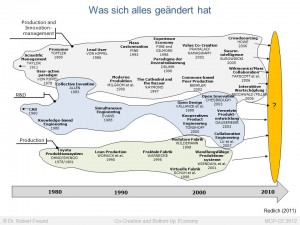 In den letzten 30 Jahren hat sich vieles geändert. Die Abbildung zeigt die Veränderungen in Innovationsmanagement, Forschung und Entwicklung und Produktion. Darüber hinaus werden auch die dazu wichtigen Veröffentlichungen genannt. Diese Übersicht war die Einstiegsfolie zu meinem Vortrag „Co-Creation and Bottom-Up Economy“, den ich auf der MCP-CE 2012 gehalten habe.
In den letzten 30 Jahren hat sich vieles geändert. Die Abbildung zeigt die Veränderungen in Innovationsmanagement, Forschung und Entwicklung und Produktion. Darüber hinaus werden auch die dazu wichtigen Veröffentlichungen genannt. Diese Übersicht war die Einstiegsfolie zu meinem Vortrag „Co-Creation and Bottom-Up Economy“, den ich auf der MCP-CE 2012 gehalten habe.
Handrich, M. (2012): The Power of Co-Creation. Managing Customer Co-Creation of Technology-Based Services
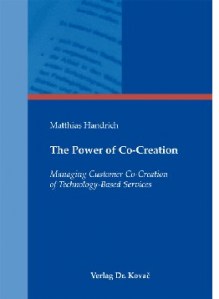 Auf das Buch von Matthias Handrich (2012): The Power of Co-Creation. Managing Customer Co-Creation of Technology-Based Services bin ich über den Blogbeitrag von Jörg Michael aufmerksam geworden – Danke: „Customer co-creation has become the next frontier in service and innovation management. Driven by the rise of the internet customers can actively engage in the development and delivery of products and services thereby taking innovation to the next level. The recent success of social media platforms and e-commerce shops impressively document the popularity of co-created technology-based services“. Der Ansatz ist mir ein wenig zu technologie getrieben. Siehe zum Thema auch die MCP-CE 2012, die wir unter der Überschrift Co-Creation in Central Europe vor einigen Wochen durchgeführt haben.
Auf das Buch von Matthias Handrich (2012): The Power of Co-Creation. Managing Customer Co-Creation of Technology-Based Services bin ich über den Blogbeitrag von Jörg Michael aufmerksam geworden – Danke: „Customer co-creation has become the next frontier in service and innovation management. Driven by the rise of the internet customers can actively engage in the development and delivery of products and services thereby taking innovation to the next level. The recent success of social media platforms and e-commerce shops impressively document the popularity of co-created technology-based services“. Der Ansatz ist mir ein wenig zu technologie getrieben. Siehe zum Thema auch die MCP-CE 2012, die wir unter der Überschrift Co-Creation in Central Europe vor einigen Wochen durchgeführt haben.
Anisic, Z.; Freund, R. (Eds.) (2012): Proceedings of the 5th International Conference on Mass Customization and Personalization in Central Europe
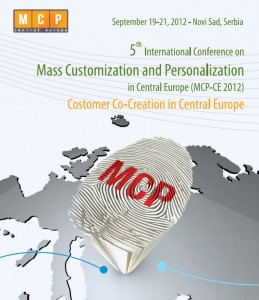 Die Konferenzbeiträge zur MCP-CE 2012 sind veröffentlicht unter Anisic, Z.; Freund, R. (Eds.) (2012): Proceedings of the 5th International Conference on Mass Customization and Personalization in Central Europe, MCP-CE 2012. Bei Interesse wenden Sie sich bitte per Mail an Dr. Zoran Anisic. Natürlich können Sie sich auch gerne an mich wenden. Siehe dazu auch diesen Blogbeitrag.
Die Konferenzbeiträge zur MCP-CE 2012 sind veröffentlicht unter Anisic, Z.; Freund, R. (Eds.) (2012): Proceedings of the 5th International Conference on Mass Customization and Personalization in Central Europe, MCP-CE 2012. Bei Interesse wenden Sie sich bitte per Mail an Dr. Zoran Anisic. Natürlich können Sie sich auch gerne an mich wenden. Siehe dazu auch diesen Blogbeitrag.
MCP-CE 2012: Das endgültige Konferenzprogramm liegt nun vor
 Für die 5. Internationale Konferenz zu Mass Customization and Personalization in Central Europe (MCP-CE 2012, 19.-21.09.2012, Universität Novi Sad, Serbien) liegt nun das endgültige Konferenzprogramm vor. Der erste Konferenztag beleuchtet die aktuellen Entwicklung bei Mass Customization. Prof. Cipriano Forza (Italien) wird hierzu einen einleitenden Vortrag halten.Ich werde in meinem Vortrag auf Co-Creation und Bottom-Up Economy eingehen. Am zweiten und dritten Konferenztag werden wir auch viele Beiträge zu Open Innovation und Co-Creation haben. Ich freue mich schon jetzt auf die anregenden Gespräche mit den vielen Kollegen.
Für die 5. Internationale Konferenz zu Mass Customization and Personalization in Central Europe (MCP-CE 2012, 19.-21.09.2012, Universität Novi Sad, Serbien) liegt nun das endgültige Konferenzprogramm vor. Der erste Konferenztag beleuchtet die aktuellen Entwicklung bei Mass Customization. Prof. Cipriano Forza (Italien) wird hierzu einen einleitenden Vortrag halten.Ich werde in meinem Vortrag auf Co-Creation und Bottom-Up Economy eingehen. Am zweiten und dritten Konferenztag werden wir auch viele Beiträge zu Open Innovation und Co-Creation haben. Ich freue mich schon jetzt auf die anregenden Gespräche mit den vielen Kollegen.
MCP-CE 2012: Customer Co-Creation in Central Europe
 Die 5. Internationale Konferenz zu Mass Customization and Personalization in Central Europe (MCP-CE 2012) findet vom 19.-21.09.2012 an der Universität Novi Sad, Serbien, statt. Insgesamt freuen wir uns auf 45 Präsentationen und viele interessante Diskussionen mit den Teilnehmern. In den nächsten Tagen werden wir das Programm an den einzelnen Konferenztagen festlegen. Möglicherweise haben Sie Lust, an der Konferenz teilzunehmen. Wenn Sie Fragen haben, können Sie sich gerne an mich werden.
Die 5. Internationale Konferenz zu Mass Customization and Personalization in Central Europe (MCP-CE 2012) findet vom 19.-21.09.2012 an der Universität Novi Sad, Serbien, statt. Insgesamt freuen wir uns auf 45 Präsentationen und viele interessante Diskussionen mit den Teilnehmern. In den nächsten Tagen werden wir das Programm an den einzelnen Konferenztagen festlegen. Möglicherweise haben Sie Lust, an der Konferenz teilzunehmen. Wenn Sie Fragen haben, können Sie sich gerne an mich werden.
Open Innovation im Bauwesen: Das Projekt Innosite
Das Projekt Innosite ist eine Open Innovation Platform for the Construction Industry aus Dänemark. Siehe dazu auch den Artikel Füller, J.: Die Demokratisierung der Architektur (Harvard Business Manager vom 31.08.2012).
Lukac, D.; Freund, R. (2012): Open Innovation, Social Embeddedness of Economic Action and its Cultural Determinants
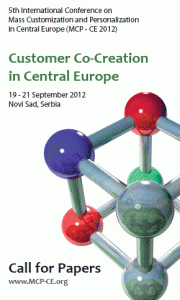 Gemeinsam mit Herrn Dr. Dusko Lukac von der Rheinischen Fachhochschule in Köln habe ich ein Paper zur MCP-CE 2012 geschrieben, das wir im September auf der Konferenz vorstellen werden:
Gemeinsam mit Herrn Dr. Dusko Lukac von der Rheinischen Fachhochschule in Köln habe ich ein Paper zur MCP-CE 2012 geschrieben, das wir im September auf der Konferenz vorstellen werden:
Lukac, D.; Freund, R. (2012): Open Innovation, Social Embeddedness of Economic Action and its Cultural Determinants
Abstract: The paper concerns the position of the economy within a socio-theoretical conception as a part of the new economic sociology, in the context of its influence of the economic action, especially in the macroeconomic view. Based on secondary research we review and challenge the primacy of economy in the contemporary society and we focus on the cultural determinantes for social embeddedness.
Siehe dazu auch Veröffentlichungen.
MCP-CE 2012: Customer Co-Creation in Central Europe
 Die von mir initiierte Konferenz MCP-CE 2012 (5th International Conference on Mass Customization and Personalization in Central Europe) findet vom 19-21.09.2012 in Novi Sad (Serbien) statt. Der Schwerpunkt liegt in diesem Jahr auf Customer Co-Creation in Central Europe. Zu den verschiedenen Perspektiven auf das Thema haben wir viele Paper erhalten die zeigen, wie facettenreich das Gebiet ist. Schauen Sie sich die Liste der Confirmed Participants und die Keynotes (u.a. Prof. Frank Piller, RWTH Aachen) an und kommen Sie zur Konferenz – ich würde mich freuen. Sollten Sie Fragen haben, so können Sie sich gerne an mich wenden:
Die von mir initiierte Konferenz MCP-CE 2012 (5th International Conference on Mass Customization and Personalization in Central Europe) findet vom 19-21.09.2012 in Novi Sad (Serbien) statt. Der Schwerpunkt liegt in diesem Jahr auf Customer Co-Creation in Central Europe. Zu den verschiedenen Perspektiven auf das Thema haben wir viele Paper erhalten die zeigen, wie facettenreich das Gebiet ist. Schauen Sie sich die Liste der Confirmed Participants und die Keynotes (u.a. Prof. Frank Piller, RWTH Aachen) an und kommen Sie zur Konferenz – ich würde mich freuen. Sollten Sie Fragen haben, so können Sie sich gerne an mich wenden:
On behalf of the Organizational Board and Scientific Committee of the 5th International Conference on Mass Customization and Personalization in Central Europe (MCP – CE 2012), we cordially invite you to participate and to share your research ideas, efforts and results with other scientists, entrepreneurs and corporate managers, dedicated to the idea of Mass Customization and Personalization.
Organized for the fifth time, the biannual MCP-CE conference would like to emphasize the role and importance of Customer Co-Creation that offers customers a chance to express their differences, and also an opportunity for innovations and new business models such as MC and Open Innovation platforms, for sharing designs and developments and benefits from the experiences of others.
Join us in Novi Sad 2012, share your ideas and become a part of our growing community.
